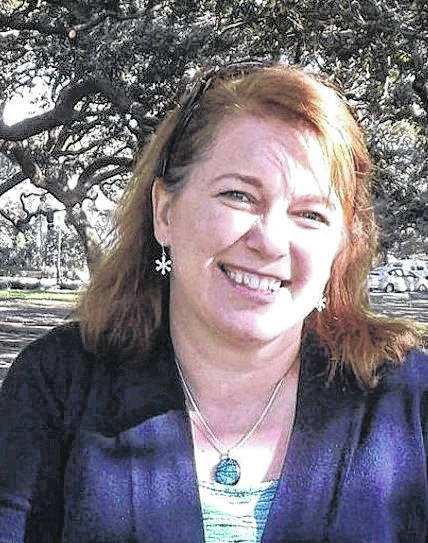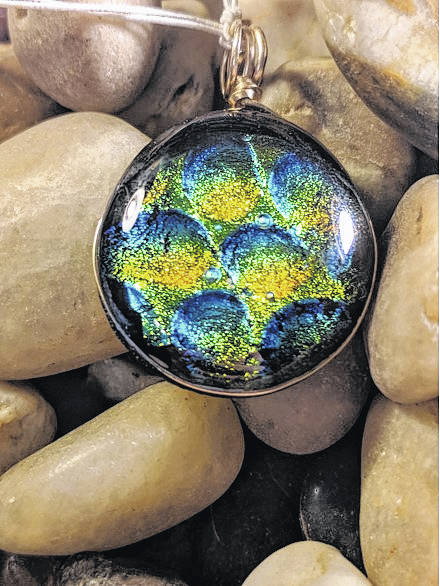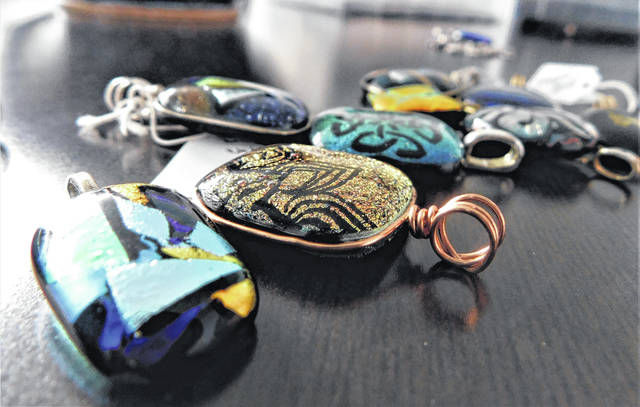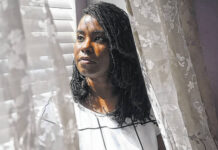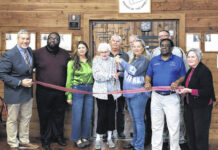PEMBROKE — According to Elizabeth Blair, constructing jewelry out of glass is less art than it is science.
“There’s more science then I think I ever realized involved in it,” Blair said.
Blair, a Pembroke resident, has been mastering the science needed to produce colorful, eye-catching pendants, rings and earrings for five years.
She first learned about glass jewelry while at the beach. She said a tropical storm hit the beach so she took her two children to a paint-your-own pottery store. At the shop, she stumbled upon a woman teaching a class on fused glass, which is a technique that melts various pieces of glass to create a combination of colors and shapes.
“I decided that I wanted to take this fused glass class,” Blair said. “So when I took the fused glass class, I fell in love with.”
Shortly thereafter Blair bought a microwave kiln, which is a smaller-scale thermally insulated chamber that produces temperatures sufficient to harden, dry or produce chemical changes.
“It was very limited in what it could do, but I just played around with that and played around with different colors of glass until I got an idea of what I was doing,” she said.
When she first started, her pieces came out in weird shapes, Blair said. But she figured out how to ground them, fire them and create the desired shapes and textures.
“It was a process of trial and error,” Blair said. “I had ideas, but I had to figure out how to make them come into fruition.”
Blair said she continued to search online and read books to learn more about the technique until she felt comfortable enough to purchase a full-sized kiln.
“You might need it to go 100 degrees an hour for the first four hours and then it gradually gets hotter,” Blair said. “And then you might need to go 200 degrees an hour for the next two hours until you get to the point where the magic happens and the glass melts.”
Blair said that for the jewelry she does, the glass gets to about 1,800 degrees Fahrenheit and then has a very slow cool-down time.
“If the glass cools too quickly it will actually crack,” she said. “So you cool it over a period of a day until it gradually cools down or naturally cools down so the glass itself doesn’t get brittle. It’s all magic.”
It’s also a lot of figuring out which colors complement each other, Blair said.
Blair uses dichroic glass. Dichroic glass jewelry is made in much the same way as fused-glass jewelry, but it has its own distinct look. Blair orders from a company in Texas solid pieces of the glass that she melts and manipulates into desired shapes.
The glass is made of pieces of sparkling, shimmering material that is then mounted onto clear or black glass. Dichroic glass is actually 50 micro-thin layers of different metals that were developed by NASA for astronauts’ face masks to protect them from radiation.
“Sometimes you’ll buy them and they’re intentionally made to be bumpy so that when they melt, it makes the dichroic part pull in different area and it creates different colors and looks,” Blair said.
The colors of dichroic glass shift and meld together when they are fired. After the pieces are lifted from the kiln and cooled, it is treated like fused glass.
“If you really don’t understand how things are happening while you’re in the kiln, then it’s harder to really come up with the idea you have in mind as an artist,” Blair said.
Blair always has been artistic.
Her first love was music. She is a adjunct professor at The University of North Carolina at Pembroke and plays piano at Sandy Plains United Methodist Church in Pembroke, where her husband is the pastor. She also makes pottery and uses a wire twisting technique for some of her jewelry. She is currently working on incorporating beading used in Lumbee tribal jewelry with her glass glass jewelry.
Blair’s jewelry can be seen at www.marcheldesigns.com.
